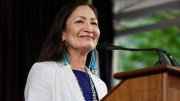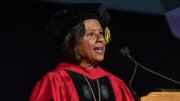Looking out at a crowd of 804 about-to-be Harvard Law School (HLS) graduates at class day May 22, U.S. Secretary of the Interior Deb Haaland spoke about work. After years of tiring study, graduates might not want to think more about labor. But Haaland did not discuss individual accomplishments. Instead, she reflected on how many people are needed to accomplish a mission.
Haaland, the first Native American Cabinet member, shared a brief anecdote from her ancestral homeland, Chaco Culture National Historical Park in northwestern New Mexico. Between 850 and 1150 C.E., Native Americans there constructed a massive house, Pueblo Bonito, out of 100 million pounds of stone. “I pictured hundreds of Pueblo peoples gathering stones, making the mud mortar, and hauling water to make it all possible,” she said. “No one in this world does anything alone.”
Now, more than ever, Haaland understands the importance of collaboration. As Secretary of the Interior, she manages a staff of 60,000 people. To accomplish her department’s goals, she must incorporate the labor of that entire group, from bottom to top.
Given the audience, Haaland focused on one type of staffer: lawyers. “I know for a fact you’re all powerful,” she told the crowd. “Harvard Law graduates and former faculty have helped lead our momentous efforts at the department since day one.”
To share Interior’s accomplishments during her three-year tenure, Haaland praised three department lawyers with HLS ties. First, she thanked Bob Anderson, solicitor of the Department of the Interior, who formerly served as the Oneida Indian Nation visiting professor of law, for his work defending the Indian Child Welfare Act. That law, which Anderson helped defend before the Supreme Court this year, restricts the removal of Native children from their families and communities. Haaland knows the pain of Native family separation. A close friend of Haaland’s was adopted out of her family, as were her six siblings, and raised apart. It’s not a new phenomenon. Haaland’s grandparents were removed from their family homes and sent to government-sponsored schools that “stripped them of their languages, their cultures, and their ways of life,” she said. “Indian Country breathed a collective sigh of relief when the Supreme Court announced its decision” upholding the law, “and we have Bob Anderson to thank.”
Next, she praised Natalie Landreth, J.D. ’01, deputy solicitor for land resources. Landreth helped secure several new national monuments. These newly-designated lands, including Baaj Nwaavjo I’tah Kukveni-Ancestral Footprints of the Grand Canyon National Monument and Avi Kwa Ame National Monument, she said, protect “ancestral homelands sacred to numerous Tribal Nations.”
Finally, she turned to Laura Bloomer, J.D. ’19, senior adviser to the solicitor. Bloomer is helping reshape rivers in the Pacific Northwest, whose flows have been altered by dams. These dams have cut off “entire swaths” of the region from salmon, on which local Native American Tribes had relied. Recently, the Department of Interior mapped a path toward salmon reintroduction in the Upper Columbia River. “Generations of children will grow up with healthier waterways and a stronger connection to the lands and waters that can sustain them because of her efforts,” she said.
“When I think about the legacy our team is building,” Haaland continued, “I think about entire landscapes—entire regions of our country—that are benefitting from our lawyers’ determination in the face of complex, oftentimes decades-long challenges.”
On one of those complex issues, she challenged Harvard. Too often, she said, universities and museums have “under-prioritized” returning sacred objects and human remains to Native American Tribes—including Harvard’s Peabody Museum. But, she did offer the Peabody some credit. In December, Interior announced a streamlined process for item identification and return, prioritizing “tribal consent.” Several museums including the Peabody, she continued, “are changing the policies and procedures that govern this work.”
In closing, Haaland challenged HLS graduates to follow in the footsteps of these three change-making lawyers. “Seize your newfound power, your influence…and your expertise, and put it to good use,” she said. “We can’t build the world we deserve without each of you.”









